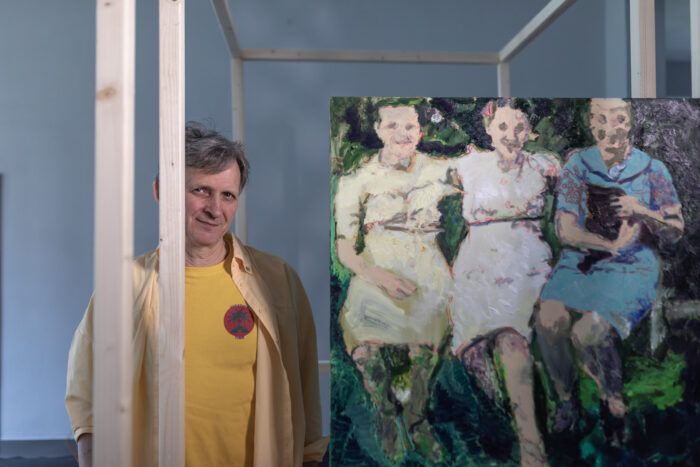
Photo: Jacek Twardowski
The history of our town and our parish can’t be honestly told without the Jews. The ghetto was within our parish boundary and the Otwock rectory became for many local Jews a safe place to shelter, get help and be assured of care.
Text by Fr Bogdan Sankowski, parish priest of St. Vincent de Paul Parish in Otwock, published in the catalogue of the Life, After All. Exhibition of paintings by Wojciech Cieśniewski.
It was with gratitude that I accepted the proposal made by the organisers of the exhibition of paintings by Professor Wojciech Cieśniewski that the show should take place in the hall of St. Vincent de Paul Parish in Otwock. This might surprise some people, but for me there’s no question that our parish should be involved in the commemoration of the 80th anniversary of the annihilation of Otwock Jews, and an exhibition of paintings inspired by photographs of Otwock Jews seems a particularly fine way of doing this.
Why do I think so? It’s quite clear that the history of our town and our parish can’t be honestly told without the Jews. In the interwar period Otwock had several synagogues and one Roman Catholic parish. Although there was no ecumenism or inter-faith dialogue in those days, relations between followers of different religions were basically good. A symbol of this could be the Yiddish-language autobiographical novel, Stepchild on the Vistula by Sam Simchovitch, who was brought up in Otwock, in which the author writes emotionally about the Orla Street figure of Christ with his cross.
The German invaders created a ghetto in Otwock and made Jewish residents relocate there. This ghetto was within our parish boundary. There was no way to stop the death machine, but there were ways to help people. So the Otwock rectory became a place of shelter, help and care for many local Jews.
The parish priest, Fr Ludwik Wolski, allowed Jews on the run to spend the night in the parish house, and even in the church. Being responsible for the registers, Fr Wolski would issue fictitious birth certificates for the children of Otwock’s Jewish residents. This way, as children from Catholic homes, they could stay legally in an orphanage.
Also directly involved in helping his Jewish compatriots was the parochial vicar Fr Jan Raczkowski, chaplain of Szare Szeregi, the underground resistance movement of Polish scouting. He persuaded his parishioners of the necessity of helping their neighbours, gave support to families concealing Jews and from the pulpit thundered condemnation on blackmailers.
Years later both Fr Wolski and Fr Raczkowski were posthumously honoured as Righteous Among the Nations for their aid to endangered Jews. The medals and certificates of both are currently on prominent display in the chapel of Our Lady, Patron of Otwock. To the best of my knowledge there’s no other parish in Poland where two priests have been honoured in this way.
Both priests cooperated closely with Otwock’s other Righteous, Aleksandra Szpakowska, Bronisław Marchlewicz and the Sisters of Saint Elizabeth. These are exceptionally important pages in the history of our parish, showing that the Christian ‘love your neighbour as yourself’ is universal and applies to everyone, not just those within your own tribe.
As the priest of a parish with such traditions, I couldn’t fail to participate in the commemoration of the 80th anniversary of the annihilation of Otwock Jews. I warmly invite everyone to our parish hall to see the exhibition of paintings by Professor Wojciech Cieśniewski.
Translated by Jolanta Scicińska
Fr Bogdan Sankowski: clergyman of the Warsaw-Praga Diocese, ordained as a priest in 1982. Has a PhD in dogmatic theology. Since 2011 parish priest of St. Vincent de Paul Parish in Otwock and vicar forane of the Otwock deanery. Since 2018 elected member of the diocesan Consilium Presbyterale.